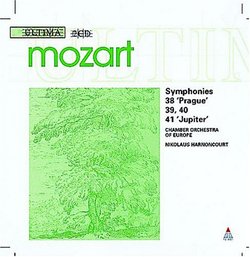Tender, furious, undeniable
Chosroes III | NC | 02/21/2004
(5 out of 5 stars)
"Unfailingly precise, though not always polite, Harnoncourt's interpretations are at once brash and unpredictable yet almost breathlessly devout. A true master of the 18th Century sensibility, Harnoncourt's chamber orchestra stylings show this music in a harsh and pure new light wherein the organic elegancies of Mozart's compositions burst forth with new life. The sublime adagio of the Symphony No. 39 gets shaken up into a burst of staccato thunder, but the rest of the symphony is rendered in tenderly familiar terms-- though the minuet has perhaps never sounded so engagingly rustic. The dreadfully difficult balance of elegance and menace called for in the latter movements of the G-minor Symphony have, I think, received their fullest expression here: the Allegro assai, so fiendishly inscrutable, reveals itself at last as a thing of tremulous beauty as well as ineffable foreboding, as brisk and shadowy as a summer's afternoon on the eve of storm. All the andantes are closer here to Vermeer in their blinding sparseness than to the native Rococo, but Harnoncourt's feeling is warm and true, and their beauty comes through with alarming clarity. The harsh timpani in the "Jupiter" are well-nigh Beethovenian, and the outer movements as one would expect from the physicality of the playing throughout, burst with muscularity. Along with the period strings there are always more idiosyncratic touches of eccentricity from Harnoncourt-- the experimental tempi and ostentatious pausings that show his mind at work to make the music his "own." He does, but the result feels like Mozart scoured of post-Romantic baggage and standing forth clean and restored. The very slight coughings that reveal this as live performance only add sweetly to the sense of communal worship. Tense, ebullient, and aggressive, these performances are as raffishly aristocratic as a pair of gold Doc Martens. Harnoncourt's sense of individual style weds itself very happily, you will find, with a reverent sense of Mozart's own radiant exceptionality."


 Track Listings (7) - Disc #1
Track Listings (7) - Disc #1